Menu
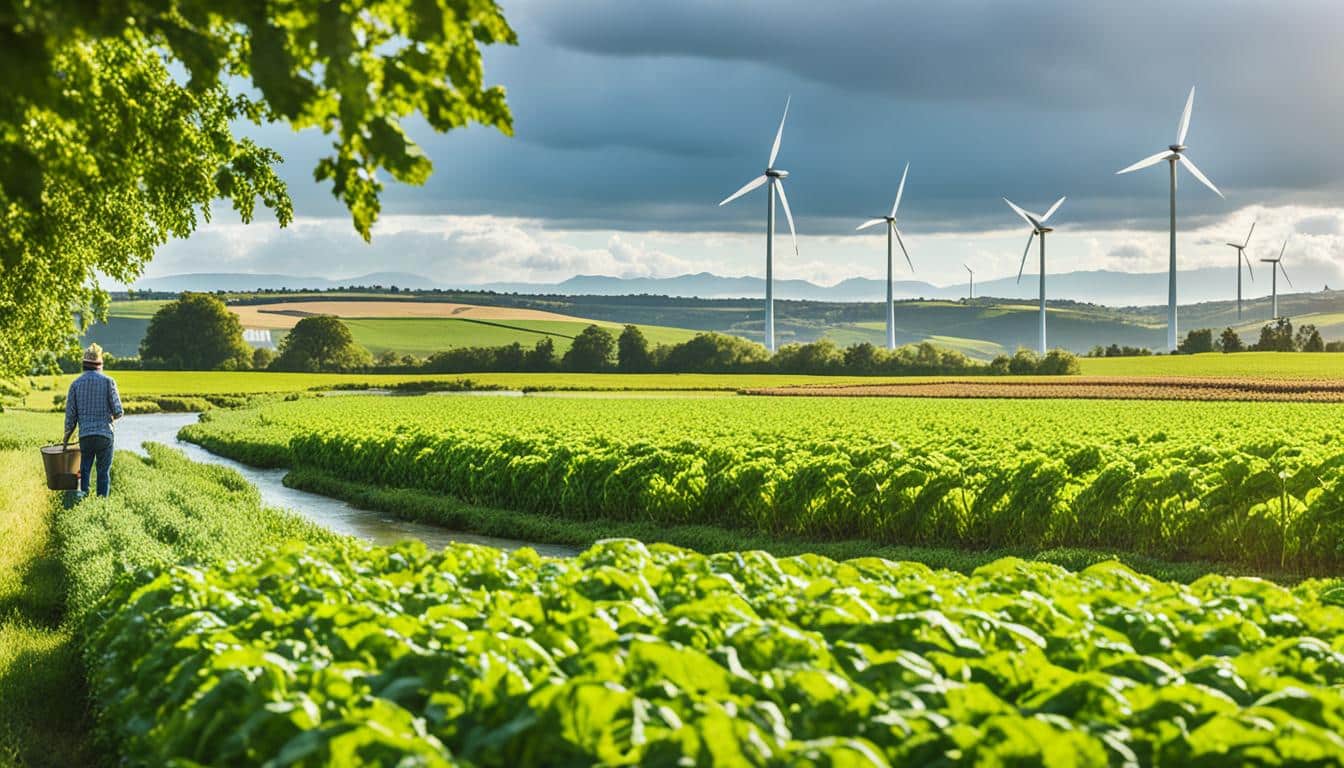
Did you know? More than 70% of the world’s 570 million farmers have under a hectare of land. Yet, they play a big role in feeding the world. The new year brings a pressing need for sustainable farming methods. With a changing climate and more people, using tech in farming is vital.
ICL, a top company, is introducing tech into farming for a sustainable future. Things like IoT, drones, and big data are changing how farms work, making them smarter. Sensors that connect to the internet are being used for better farm management. And we’re even using artificial intelligence and digital models to predict and avoid climate risks, making our food supply stronger.
This year, there’s a big focus on regenerative farming. It’s all about healing the soil and the environment. This not only makes farms better but also fights climate change. The combination of new tech and old farming wisdom is leading to greener ways of growing our food.
Using sustainable farming is key to tackling worldwide problems. It helps fight climate change, looks after our environment, and keeps food secure. These efforts lead to a strong and caring future in farming.
Climate change is a big threat to farming around the world. To tackle it, we can use smarter methods like careful grazing and fungi to improve the soil. These help the land cope with the effects of climate change better. By using these methods, farmers act ahead to protect their crops.
Making sure there’s enough food is really important, especially as the world will have more people by 2050. Sustainable farming with healthy soil and helpful little creatures plays a big part in keeping food growing. Scientists are working on making crops stronger against drought and healthier. This makes sure we can all eat enough without harming the future.
Older farming ways can hurt the earth, but new sustainable farming helps a lot. It cuts down on harm to groundwater and soil. Using natural microbe mixes and special mats in farming saves energy and protects the ground. Groups like Land O’Lakes want to ensure dairy farms are more sustainable by 2025. This helps the whole sector do its part for a brighter future.
In 2024, organic farming is key to eco-friendly agriculture. It avoids harmful chemicals, helping our planet.
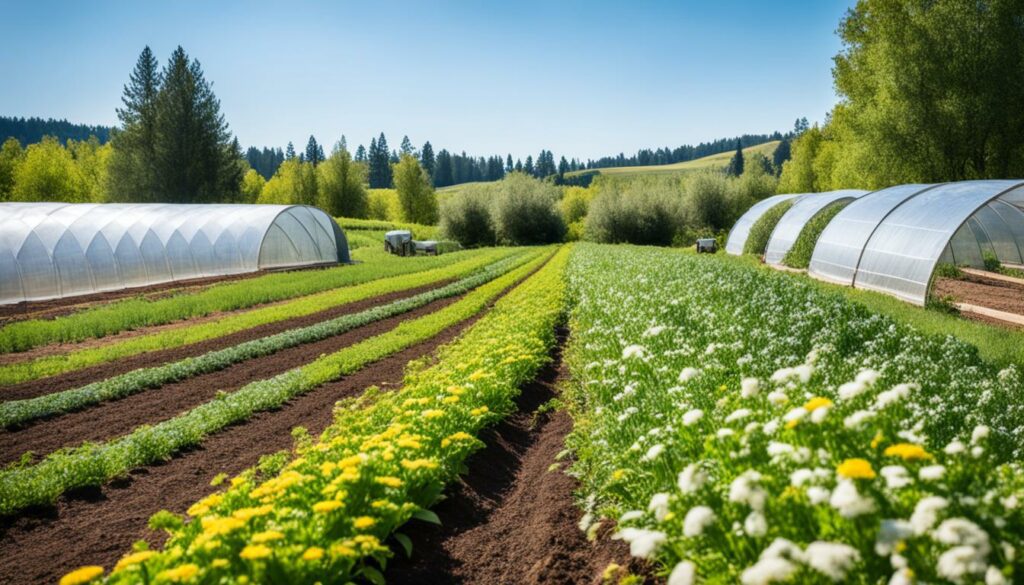
Going organic boosts the soil and the food we eat. It cuts down harmful chemicals, which is good for Earth. Groups like ICL offer tips for healthier crops, making farms better.
Organic ways make the soil better by using smart farming. They use methods like changing crops each season and natural fertilisers. This helps the land stay strong for growing food.
On hills, making steps in the soil stops the land from washing away. It protects our soil.
Here’s a look at how organic farming helps:
| Practice | Benefit |
|---|---|
| No-till agriculture | Reduces soil erosion |
| Crop rotation | Improves soil health |
| Windbreaks | Protects soil from the wind |
| Terracing | Prevents soil loss on slopes |
| Green manure | Feeds the soil with nutrients |
| Limestone application | Adds Calcium, good for the soil |
These steps make the soil better and farming last longer. They keep our food coming, even when times are tough.
In 2024, the focus on eco-friendly farming is crucial. It’s about saving the soil and water and using less chemicals. This helps make farming better for the planet and for the future.
Keeping the soil healthy is key in eco-farming. Not tilling the soil or tilling it a bit helps keep the soil’s structure and health. Farms that grow different crops together help the soil and control pests better. Also, plants like cover crops and trees that stay all year help stop the soil from washing away. They make the soil a better home for plants and bugs.
Using water wisely in farming is very important. New irrigation systems and smart tech help water the plants just right. This cuts down on using too much water. Putting mulch around plants helps the soil keep more water. These steps make sure not to waste any water. They help save this vital resource for the future.
Farming with fewer chemicals is a big aim now. Strategies like using helpful bugs to control pests have lessened the need for harmful sprays. Mixing different types of farming and adding trees not only make farms stronger but also help nature. Having animals and crops together also makes farms work better. They help the soil trap more carbon, which cuts down on bad chemicals used in farming.
Regenerative farming is getting more focus for its green benefits. Big companies like PepsiCo, Walmart, and Cargill aim to grow regenerative farming to millions of acres by 2030. The goal is to reduce greenhouse gases and bring back ecological balance.
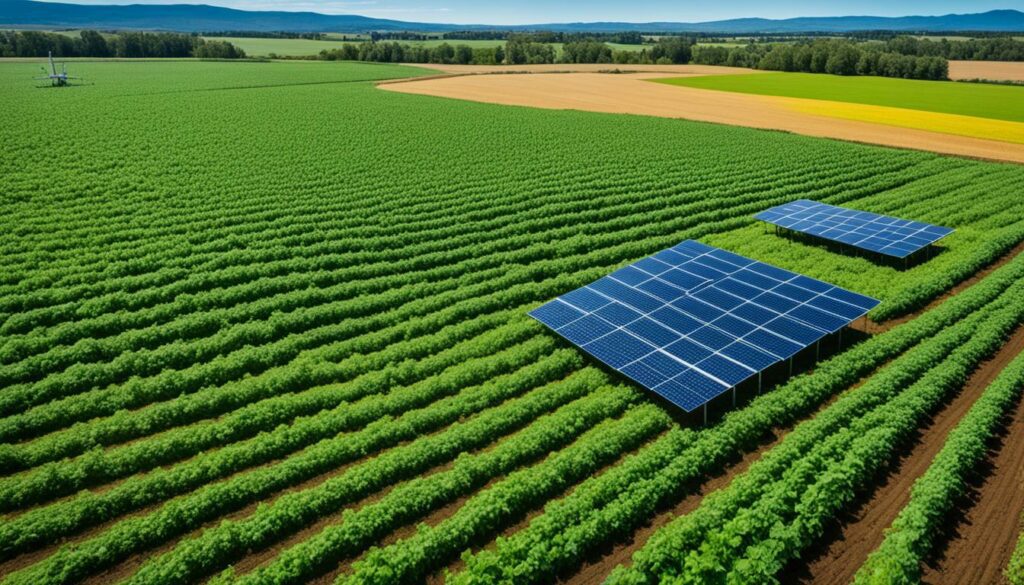
Adaptive grazing is a smart way to use animal grazing to make soil healthier and increase biodiversity. This method manages where livestock graze to better cover the land, add organic matter to the soil, and capture more carbon. It also fights erosion and helps farms handle changes in weather better.
No-till farming is key in regenerative farming. It keeps soil from being turned over traditionally. This way, the soil’s structure remains, it holds water better, and doesn’t wash away. It’s good for taking in more carbon, lets water in well, and supports strong plant roots. All this means no-till farming is vital for healthy soil.
Regenerative farming really focuses on making farm life more diverse. By planting different crops together and adding trees to farms, it makes a balanced environment. This helps with different plants and animals living together in harmony. Unilever guides on regenerative farming show how this supports nature. More biodiversity equals stronger soil life, better pest defence, and a farming world that can face challenges and keep providing food.
Today, regenerative farming is all about big promises from companies and new ways to farm. These methods are the future for a greener, healthier planet. They are key to dealing with our environmental problems and making sure we all have a good life.
The world is seeing a big push for sustainable farming in 2024. With big challenges like pandemics and tensions between countries, easy solutions no longer work. Now, we’re all about ways that are good for our planet and still productive. Eco-friendly farming is at the heart of this, aiming to keep our food system strong for the long haul.
One of the stars in this effort is the use of new green nanomaterials. They’re helping a lot in growing fruits and veggies with more to harvest and less pests. Take, for example, the growth of maize and Eucalyptus trees together in South Africa. This mix has done wonders for the soil, a key part of farming well for the future.
There’s also a buzz about using special fungi to help crops. These fungi make nutrients in the ground easier for plants to use and help them deal with tough weather. All over, using a lot of different bacteria, like cyanobacteria, is adding another layer of eco-friendliness to farming. It’s really exciting stuff for the agriculture of tomorrow.
Combining high-tech like AI with the farming we already know is making our food system stronger. These new ways of farming help make more food while dealing with the risks of a changing climate. This tech is also shaping how students at agricultural colleges learn, getting them ready for a future focused on nature.
The government is also stepping up to the plate, offering big money for green farming projects. There’s a $44 million pot for organic farming research and $6 million for city farming projects. This support is a crucial part of the sustainable farming story.
We can’t forget about new farming flavours like growing up instead of out and bringing fields back to life. Vertical farming saves space and is making a big mark in farming, both small and big. At the same time, rewilding is all about letting nature take back some areas. This keeps our farming in harmony with the environment.
Last but not least, regenerative farming is a trending topic. It’s all about farming in ways that help the land heal, like not tilling too much and using different plants to cover the soil. This approach makes the ground better for farming, all while being kind to the Earth itself.
Digital agriculture is changing the game in farming. It uses IoT in farming, drones, and data analysis, making farming smarter and more eco-friendly.
IoT has totally changed how farms work. It helps keep an eye on the weather and soil. This lets farmers make very detailed choices to grow better crops. Now, sensors in the ground and on machines watch over the farm’s health.
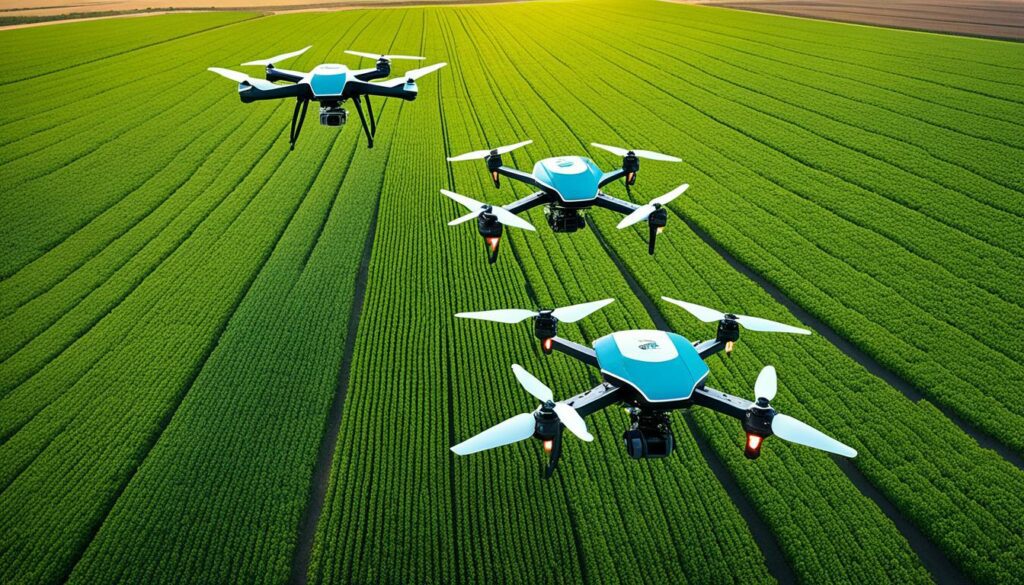
Drones and robots are becoming farmers’ best friends. Drones take pictures from above, catching crop problems early. This saves time and cuts down on how much is wasted, making farms work better.
Using big data and smart tech, farmers can guess what’s going to happen in their fields. By looking at lots of info, they can plan ahead to deal with troubles. This helps save water and make crops better, fitting with the aim of farming more sustainably.
| Aspect | Implementation | Benefits |
|---|---|---|
| IoT in Farming | Sensors and devices monitor soil moisture and weather conditions | Optimises resource use and enhances crop yield |
| Agricultural Drones | Drones provide aerial imagery for crop monitoring | Improves precision and addresses labour shortages |
| Predictive Analytics | AI analyses big data for yield prediction and risk mitigation | Conserves resources and substantially improves yields |
Digital farming is key to tackling today’s farming issues. Combining IoT, drones, and data analytics promises a future where farming is both efficient and earth-friendly.
Climate-smart agriculture combines new tech with eco-friendly farming. It helps farmers deal with changing weather and lessen harm to the environment.
Predicting the weather is key in smart farming. Farmers use weather data to adjust their methods. This helps them avoid weather risks and get the best crop yields.
Storing carbon in the soil and plants is vital. Methods include not ploughing too much, planting more crops to cover the ground, and using a form of charcoal called biochar. These methods make the soil healthier and keep carbon out of the air.
The World Bank is putting more money into these green farming ways. By 2023, they’ll spend nearly $3 billion a year. Also, countries like China are investing millions in making farming better for the planet. This shows the world is serious about fighting climate change through farming.
These smart farming methods help farmers grow food in a safer, long-lasting way. They limit harm to the planet and ensure there’s enough food for the future. This is important as we expect to have 9.7 billion people to feed by 2050.
Recently, the way we make food has changed a lot. This change is because we’re using more local products and organic foods. Problems with food supply from far away have made people look for food that’s closer to home. This shows we want food that’s good for us and the planet.
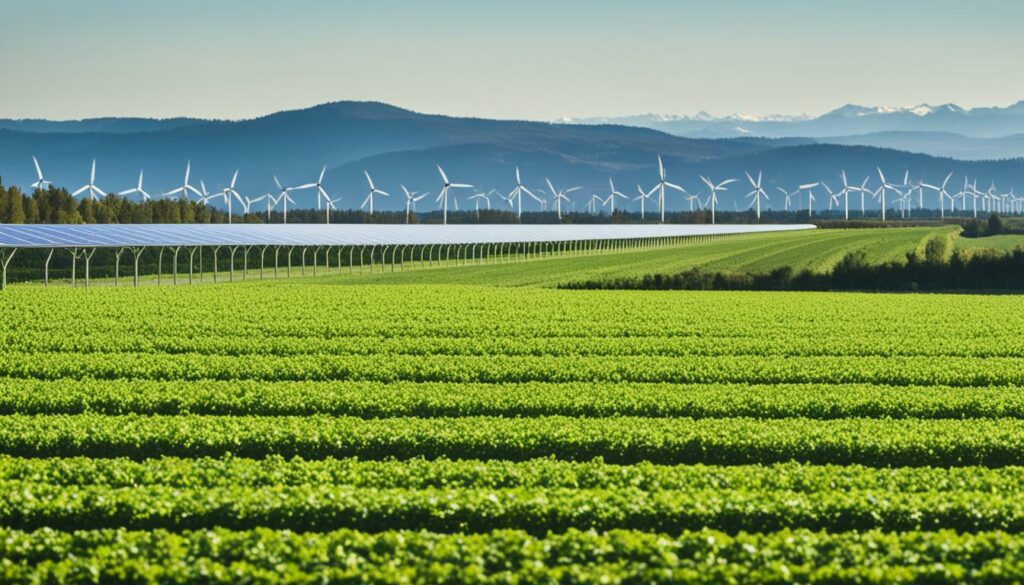
Growing food nearby helps keep things like sustainable, open, and strong. It’s a way to make and share food that’s better for nature. ICL helps by teaching farmers how to grow food well, making it more and better.
More people want organic food because it’s better for the Earth and them. Studies by Mintel show that caring for the Earth is now part of making products. Around the world, people are looking for food that’s made wisely. ICL is working hard to be part of the future of good food, grown close by.
In the push for green living, new ways to cut food waste are key. ICL’s new products, like ones that make food last longer, help a lot. This matters a ton because we waste a third of our food each year. It’s from not storing it right and throwing some away.
| Statistic | Insight |
|---|---|
| One-third of food produced is wasted globally | Need for improved storage technology and consumer awareness |
| ICL’s farmer training programs | Enhanced yields and sustainable quality improvements |
| Increased demand for organic products | Integrated sustainability into business models is critical |
Green tech in farming is changing the way we grow our food. It combines high yields with care for the planet. Innovations like bio stimulants help plants grow better and handle stress. Drip irrigation saves water, making farming more sustainable.
Farmers worldwide see sustainability as key. Lots of food is wasted because of poor storage and consumer habits. Smart apps and storage tech are cutting down this waste. The desire for organic food is also boosting these efforts.
People want to know where their food comes from. They’re choosing local products that are grown with care. This drive supports farming methods that improve soil and protect nature. A Mintel report says being sustainable is a must for all farms now, not just a good extra.
ILC leads the way in farming innovation, offering advice and digital solutions. By using big data and AI, they help farmers grow more while being kind to the environment. The Precision Agriculture Market is growing fast. This shows more farmers are using smart tech to save resources and get better crops.
Using green tech is about more than just being green. It’s about making agriculture fit for the future. These advances meet the needs of a growing population. They also ensure our food system can stand the test of time.
AgTech in sustainable farming is changing the way we look at agriculture. It brings us digital twins and AI. These, along with precision agriculture technologies, boost efficiency and reduce costs. They also help farm in ways that are kinder to the environment.
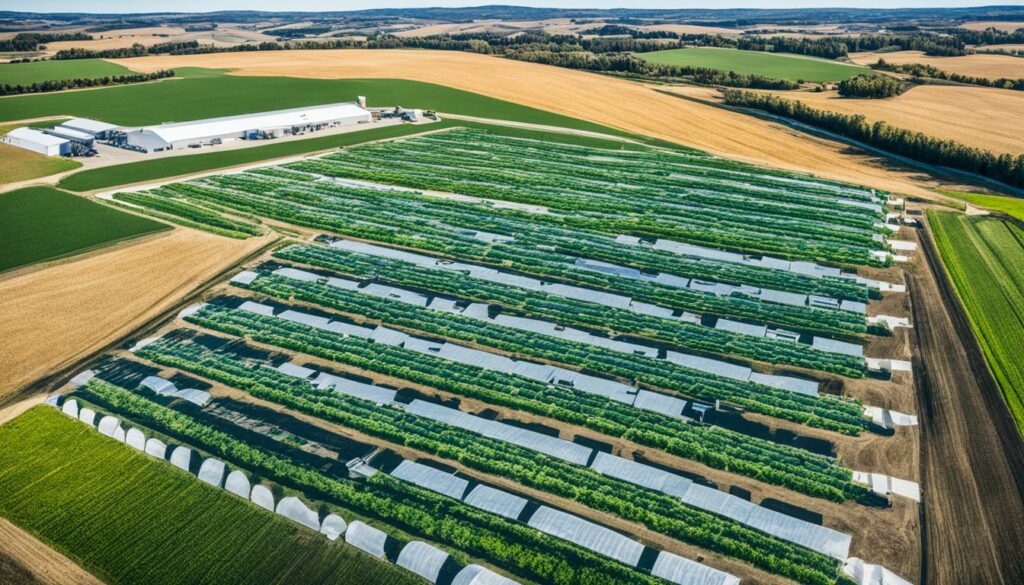
Digital twins in farming bring the real world to virtual models. This lets farmers look closely at their data. It saves time and money by finding and fixing problems early. AI adds to this by making predictions about crop needs. This helps use resources wisely for better harvests. Farmers can make smarter choices and reduce risks using this tech.
Precision agriculture makes farming better by using tech for smart farming. It uses resources like water and fertilizers the best. For example, cloud-powered farming can cut water waste by 30%. In California’s Central Valley, drip irrigation has increased tomato yields by 48%. It’s a big step in using water smarter, since farming uses most of the world’s fresh water.
This tech also helps with nutrient runoff. It makes waterways cleaner and protects aquatic life. It shows how crucial AgTech is in updating farming. It helps farms be more sustainable and make more money.
Plant-based and lab-grown proteins are becoming more popular. This shows how our eating habits are changing and are more nature-friendly. Many people are choosing these new protein sources. This choice is making a big difference in the way we use our land and grow food.
Choosing plant-based proteins is good for our health. They have less bad fats than meat and a lot of important nutrients. Lab-grown proteins are made to be nutritious, like regular meat, but without the bad stuff. They don’t have the unhealthy extras that some meats do.
Plant-based and lab-grown proteins also help our planet. Farming animals adds a lot to the greenhouse gases in our air. It takes a huge amount of water to make beef, too. But making meat in a lab could cut down on pollution by a lot and save land, mostly by not using up as much water.
The need for plant-based proteins is changing how we grow crops. Fields that used to grow food for animals are now growing things like soybeans and peas. These plants are good for the earth because they help the soil stay healthy. This switch in farming is good for the planet.
Today, we’re tackling big challenges with food waste. It points to the need for solutions in *food storage technologies* and *shelf-life extension.* In developed places, too much buying and not storing food right cause waste. On the other hand, developing areas lose food earlier, mostly because they lack good stores and ways to keep food fresh during transport.
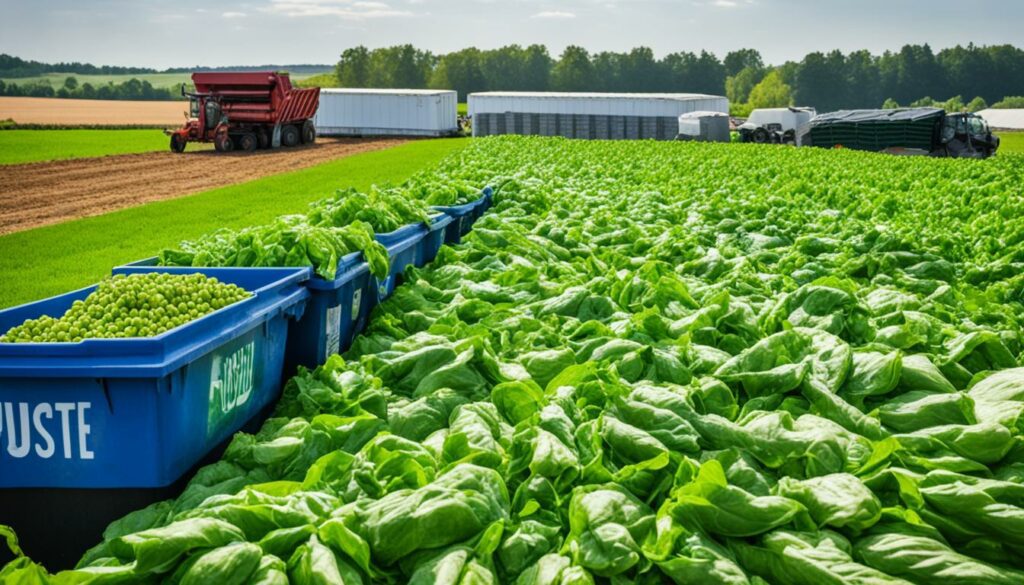
New *food storage technologies* are changing how we keep fruits and vegetables fresh. Tools like sensors, GPS, and drones are making farming smarter. Growing food up in the air with vertical farming saves space. This also means less food gets spoiled while being transported. Together, these methods use resources better and stop food from going to waste.
Using *shelf-life extension* technologies is key to cutting food waste. Both new and known companies are creating ways to make food last longer. For instance, ICL has a product called FruitMag™ that helps citrus stay fresh for longer. Such innovations ensure we can keep produce fresh, giving us more time to use it. This helps lower the bad effects of throwing away food.
Putting these ideas into practice helps lower the amount of food we waste. It also helps farming be greener. By making things more efficient and using resources in a smart way, we help make sure there’s enough food. And we do this without harming our planet too much. Teaming up technology with good practices is key to using all our food and making a stronger food system.
Government efforts and industry teamwork are key in moving sustainable farming forward. They fund projects and work together to make farming more eco-friendly. This boosts the number of farmers who take part and the positive effects of these efforts, like EQIP. The joint work of the public and private sectors is vital for the current and future success of sustainable agriculture.
Government funds are crucial for teaming up on sustainable farming. In FY 2024, a big part of the budget, $80 million, is set aside for advanced farming methods. This money will help reach important goals like smart farming and improving nutrition, changing how America grows its food. Grants range from $50,000 to $10 million, with support for students and researchers included in proposals. Plus, in FY 2024, there’s no need for a preliminary letter, making applying much easier.
Working together with the farming industry is key to making farming greener. For example, in the AGRI:AI Coding Challenge, experts come together to solve farm issues with technology. This effort involves top groups like the Data Institute and the USDA. By working in teams, they tackle big farming problems while aiming for rewards like a First Place scholarship worth $2000. Such alliances mix government support and business innovation, pushing for greener farming that benefits everyone.
| Funding Programme | Anticipated Funding | Award Range | Focus Areas |
|---|---|---|---|
| Sustainable Agricultural Systems FY 2024 | $80,000,000 | $50,000 – $10,000,000 | Climate-Smart Agriculture and Forestry, Strengthening the Bioeconomy, Nutrition Security |
Embracing sustainable farming is vital for the future, but it’s not easy to start. The number of farms in the US has dropped by around 70,000 from 2007 to 2017. This shows that farmers find it hard to make a living. The high cost to switch to sustainable farming doesn’t help. For example, a no-till planter can be between $25,000 and $50,000. And precision seeders can cost over $100,000. These big prices make it tough for farmers.
Farm closures have increased, showing the hard times in agriculture. Using organic stuff, like compost or manure, is more expensive. It can cost $30 to $100 for a ton. While organic weed killers can be $100 to $200 a gallon, mainstream ones are only $20 to $50. Plus, getting USDA organic certification yearly might cost hundreds to a few thousand dollars. This makes it harder for farmers to switch to sustainable ways of farming.
There’s also a need for better teaching and knowing about the struggles of sustainable farming. Smaller farmers often can’t get the resources or info they need. This includes both knowledge and the money to start making changes. Consumers not understanding what sustainable farming is about makes things worse. It means there’s not enough demand for eco-friendly goods.
Problems with technology in farming are also a big challenge. Many farmers can’t afford the latest tech. Climate change makes things harder, with its hot temperatures and strange weather. This makes using new tech even more difficult. The land becoming less fertile, water problems, and less biodiversity are other big issues. We need to address these problems with sustainable solutions.
Dealing with these issues is very important. Better policies, incentives, and teaching can help. By supporting farmers, we can make the move to sustainable farming easier. This would ensure a farming future that’s strong and good for the planet.
In 2024, the world will focus on eco-friendly farming. This means using methods that protect the earth. This includes regenerative farming and organic ways. We will also see more high-tech tools used on farms. All of these help fight climate change, make sure we have enough food, and keep our planet safe.
It is vital to farm in ways that do not harm our planet. Using smart farming and less chemicals helps protect nature and our future food supply. It’s all about being careful and creating a strong, lasting environment for farming.
Organic farming is great for the soil and the wildlife that lives there. It grows food that is full of goodness and free from chemicals. These methods keep food growing strong and the land healthy, without relying on man-made products.
Farming without tilling the soil, smart water use, and less chemical spraying are eco-friendly. They help save land, use water well, and keep nature thriving. These methods are gentle on the earth while growing plenty of crops.
The future of farming includes new ways to manage animals and plants. Techniques like not tilling the soil, and taking care of the whole farm’s nature are key. They make the soil better, trap carbon, and help nature heal.
Digital farming is changing how we grow food using technology like sensors and drones. It helps farmers use less and produce more by knowing exactly what each plant needs. This makes farming smarter and more efficient.
Climate-smart farming uses the latest tech with old farming knowledge to fight weather changes. It looks closely at the weather and uses special crops and methods to protect the land. This way, farming continues to be good for the planet.
People want food that they know is good for them and the earth. This means buying food that is grown nearby, and that is grown without chemicals. These choices make sure there’s enough food and cut down the risks of long supply chains.
Green farming involves using natural boosters, being careful with water, and the latest farming tech. These are the next steps for farming, bringing more food without harm. They show how farming and the environment can work together well.
New technology like digital copies of farms and AI help farmers make the best choices. This means predicting what will work to grow food in the best way. It’s a smart approach to using the land and resources well for farming.
More people are wanting foods that don’t come from animals directly. This includes growing special plants and making proteins in labs. These choices are not only good for health but also for the earth. They show a new direction for where our protein comes from.
Agriculture is finding new ways to keep food fresh for longer. Innovations like FruitMag™ for citrus help cut down how much food is thrown away. Less waste means a cleaner planet and more food to share.
Both the government and businesses need to work together for better farming. They help by funding new technology and teaching farmers the best ways to grow food. This teamwork is essential for a healthy future in farming.
Farming in a way that’s good for the planet can be difficult because of money, what we know, and what tools we have. Farmers need help to earn more for their kind of farming and get the knowledge and tech they need. These are big steps to support farming that’s good for us and the earth.